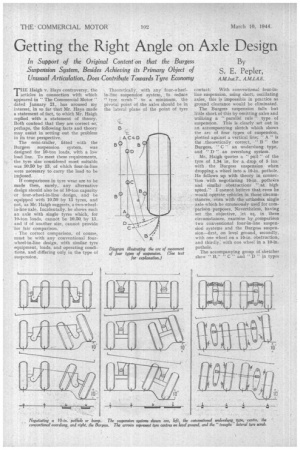Getting the Right Angle on Axle Design
Page 24

Page 25

If you've noticed an error in this article please click here to report it so we can fix it.
In Support of the Original Content 'on that the Burgess Suspension System, Besides Achieving its Primary Object of Unusual Articulation, Does 'Contribute Towards Tyre Economy
By S. E. Pepler,
A.M.I.A.E.
THE Haigh v. Hays controversy, the articles in connection with which appeared in "The Commercial Motor " dated January 21, has aroused my interest, in so far that Mr. Hays made a statement of fact, to which Mr. Haigh replied with a statement of theory. Both contend that they are correct so, perhaps, the following facts and theory may assist in setting out the problem in its true perspective.
The semi-trailer, fitted with the Burgess suspension system, was designed for 10-ton loads, with a low load line. To meet these requirements, the .tyre size considered most suitable was 10.50 by 13, of which four-in-line were necessary to -carry the load to be imposed,
If comparisons in tyre wear are to be made then, surely, any alternative design should also be of 10-ton capacity or four-wheel-in-line design, and be equipped with 10.50 by 13 tyres, and not, as Mr. Haigh suggests, a two-wheelin-line axle. Incidentally, he shows such an axle with single tyres which, for 10-ton loads, cannot be 10,5Q by 13, and if of another site, cannot provide for fair comparison.
. The correct comparison, of course, must be with any conventional fourwheel-in-line design, with similar tyre equipment, loads, and operating conditions, and differing only, in the type of suspension. Theoretically, with any four-wheelin-line suspension system, . to reduce
tyre scrub " to a minimum, the pivotal point of the axles should be in the lateral plane of the point of tyre
contact: With conventional four-in line suspension, using short, oscillating axles, this is impossible in practice as ground clearance would be eliminated.
The Burgess suspension falls but little short of this by omitting axles and utilizing a " parallel rule" type of suspension. This is clearly set out in art accompanying sketch which shows the arc of four types of suspension, plotted against a vertical line; " A " is the :theoretically correct, " B " the
Burgess, C "! an underslung type, and "D ". an overslung system.
Mr. Haigh quotes a " " of the tyre of 1.34 in, for a drop. of 5 ins: with the Burgess suspension, when dropping a wheel into a 10-in, pothole.: He follows up with theory in, Connection with negotiating 10-in. pothaes and similar obstructions ". at high speed." I cannot believe that even he 'would operate vehicles in thoSe circum-stances, eVen :with the orthodox single -axle which he erroneously used for cornparisbn purposes.'Nevertheless, having set the objective, let us, in . these circunistances, ,examine bT.,comparison two conventional fonC-in-line suspension systems and the Burgess suspension----Orst, on level ground, secondly, with one Wheel on a 10-in, obstruction, and thirdly: with one wheel in a 10-in. pothole. The accompanying group of sketches show " B," " C" and " D " in type; as referred to. At the foot is shown the point of tyre contact for each position with the respective suspension systems, which demonstrate the infinitely reduced " 'tyre scrub " with the Burgess suspension.
Mr. Hays stated that, with the Burgess suspension, the wheel follows the contour of the ground—a simple, , plain statement of fact. Mr. Haigh stated that it is reasonable to conclude that, instead of the Burgess wheel following the ground contour, exactly the opposite should occur--a simple, plain statement of theory.
It may not be inappropriate here to q note—with acknowledgments:— According to aeronautical technical tests the bumble-bee cannot fly because of the shape and weight of his body in relation to total wing area. But the bumble-bee doesn't lmow this, so he goes ahead and flies away." • Mr. Haigh may be correct, in that the Burgess suspension design Was mainly concerrnd with abnormal articulation and not with reducing tyre wear, but this does not alter the fact that there is a remarkable difference in tyre wear in favour of the Burgess suspension.
One of my responsibilities, for some time past, has been tO maintain tyre equipment on each of the tyres " B," C ' and " D;" to which reference has been made, all operating under similar conditions and loads. Other, than this I have no interest in them.




















































